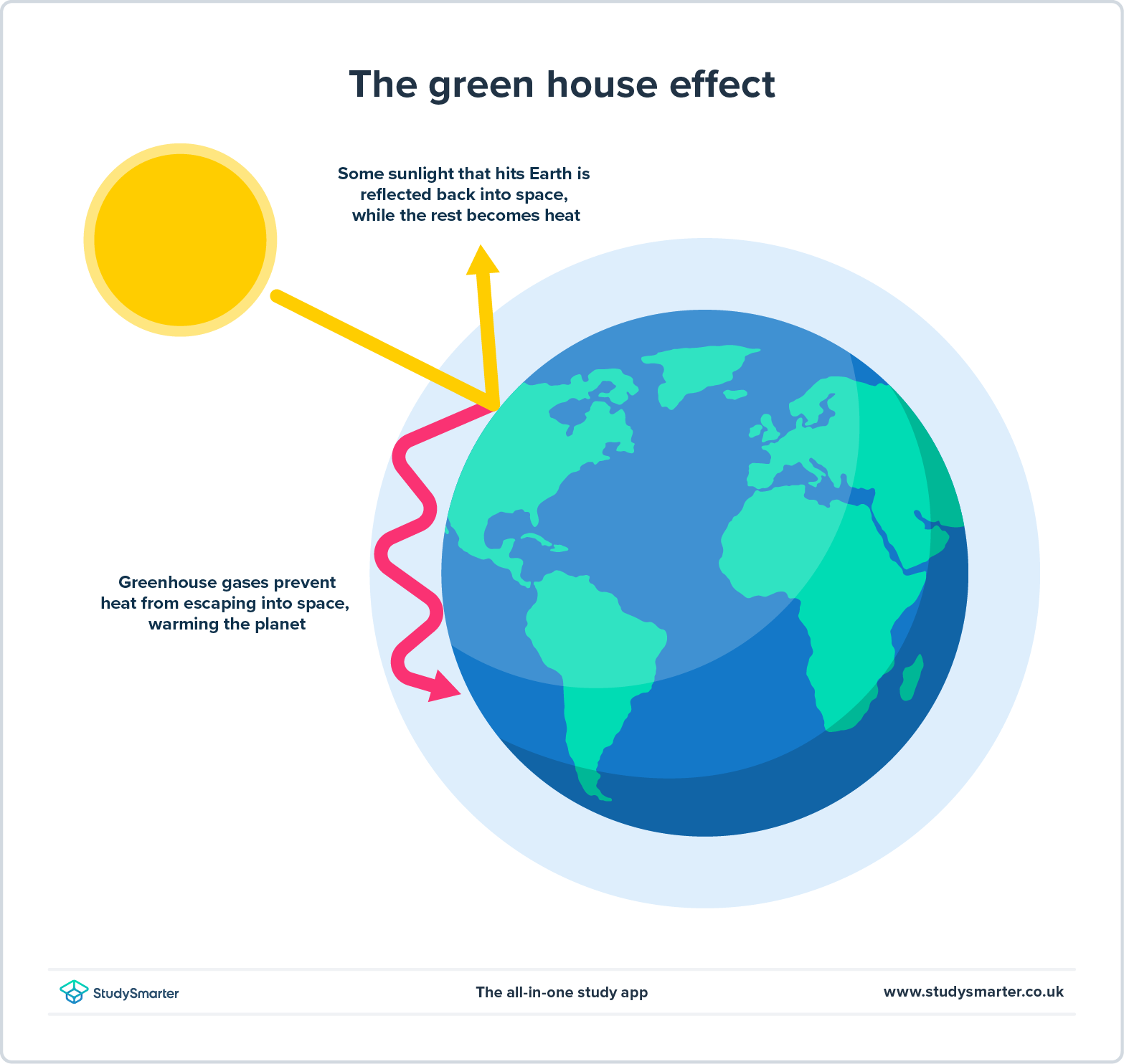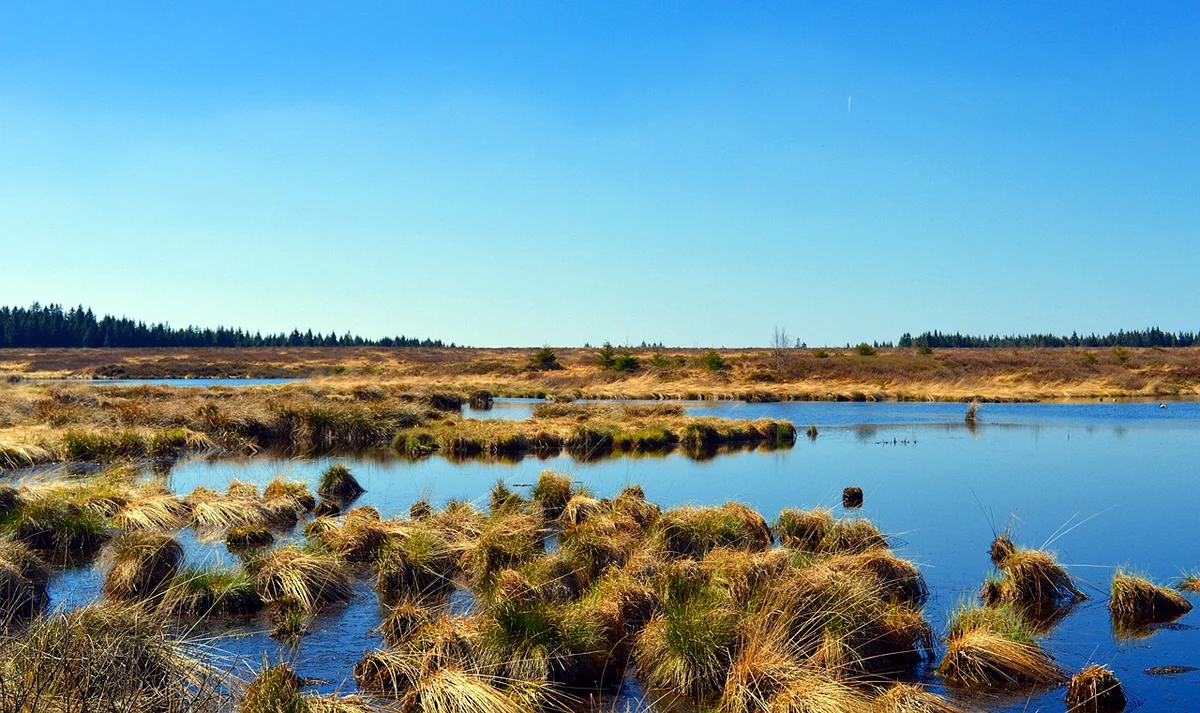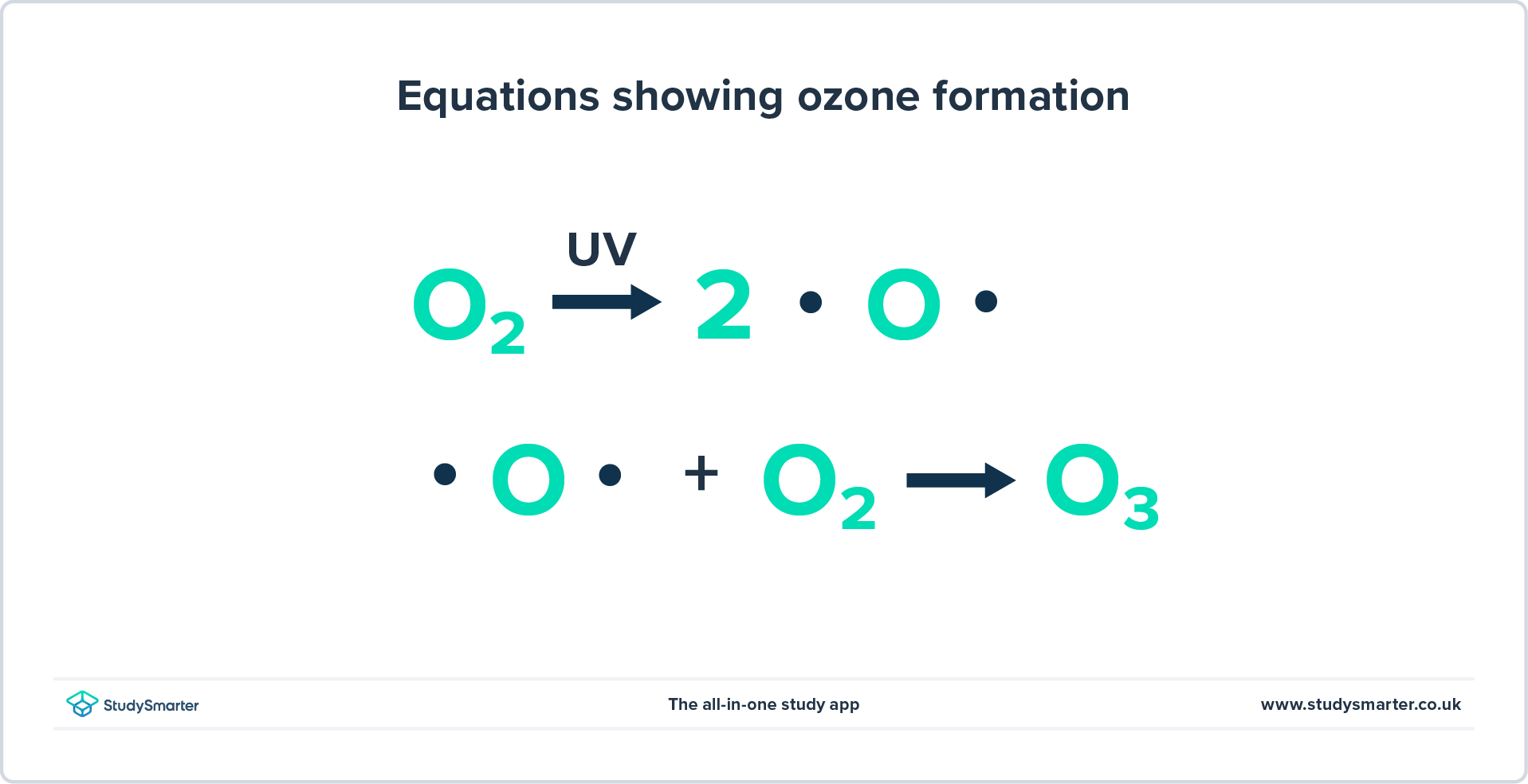We'll learn about greenhouse gases, their sources, the greenhouse effect, and their impact on global warming, and we'll see some examples.
Greenhouse Gases Definition
Greenhouse gases are substances which absorb infrared radiation reflected from the Earth’s surface and release this radiation back towards the earth, warming the planet in the process. These gases act in the same way as the glass walls of a greenhouse.
Mathematician Joseph Fourier proposed the greenhouse analogy. When considering the glass walls of a greenhouse, sunlight enters the house and warms the inside. Infrared radiation from the sunlight is absorbed and re-emitted from the ground, but the glass walls will trap this radiation inside. Greenhouse gases act much in the same way, but on an atmospheric scale.
The Names of Greenhouse Gases
Some examples of greenhouse gases are:
- Water vapour
- Carbon dioxide
- Methane
- Nitrous oxide
- Chlorofluorocarbons
We describe them below in the Examples section.
The Greenhouse Effect
The greenhouse effect is a natural phenomenon which has allowed terrestrial life to thrive. Without it, the terrestrial environment would be too cold and life would be restricted to the sea. The natural greenhouse effect occurred because of ocean water evaporating and forming water vapour, which is a greenhouse gas. The Earth’s natural internal variability caused there to be enough water vapour in the atmosphere to create a greenhouse effect large enough that life on our planet could be sustained. The greenhouse effect maintains an average temperature of 15 °C on Earth.
Terrestrial simply means on the Earth, so terrestrial life includes all life on the Earth’s surface while aquatic life includes organisms in the oceans.
This is how the greenhouse effect works (Fig. 1):
The majority of the solar radiation from the sun passes through the atmosphere and is absorbed by the Earth’s surface, warming its temperatures in the process.
Some radiation is absorbed by greenhouse gases and re-emitted, while other radiation is reflected by the atmosphere or the Earth’s surface.
Some of the infrared radiation reflected by the Earth’s surface will be absorbed by greenhouse gases in the atmosphere and re-emitted in all directions, including back towards the Earth, resulting in further warming of the surface.
Greenhouse gases will re-emit infrared radiation in all directions, meaning that some radiation will be sent back into space while some will warm the atmosphere.
Modern Global Warming
Since the Industrial Revolution of the 1800s plus developments in technology and agriculture, masses of unwanted greenhouse gases have been released into the atmosphere. The release of these gases has added to the greenhouse effect, resulting in the evaporation of more ocean water releasing water vapour into the atmosphere, which amplifies the greenhouse effect. This has led to global temperatures increasing to unprecedented levels. There are certain negative feedbacks which the Earth exhibits to counteract these changes, such as increased cloud formation, but these are not enough to halt global warming alone. Anthropogenic greenhouse gas emissions must be massively reduced or stopped completely to reduce the impacts of climate change on the planet.
An example of a global initiative to reduce the effects of climate change is the Paris Agreement which has the objective of net-zero carbon emissions by 2050 and to limit warming to 2 °C at least by 2100, preferably 1.5 °C.
Greenhouse Gases Diagram
The following diagram shows the greenhouse effect.

Fig. 1 - The Earth's greenhouse effect.
Negative feedbacks are mechanisms by which the Earth responds to rising temperatures by producing a change to a certain climatic condition that will reduce global temperatures (i.e. cloud formation, albedo, carbon cycles).
Various global warming-induced positive feedbacks will reduce the effects of negative feedback. For example, warming will result in decomposers working much faster. This will release more carbon dioxide into the atmosphere while causing an excess of nutrients in soils, which could negatively impact crop fertility,
Sources of Greenhouse Gases
The sources of greenhouse gas emissions are diverse, but the vast majority stem from burning fossil fuels. Fossil fuels are non-renewable, carbon-rich deposits. When burned, they release energy - but also carbon dioxide and other greenhouse gases.
Fig. 2 shows the greenhouse gas emissions by main sectors in the UK for the year 2019. For example, it shows that transport, electricity and heat, and buildings, are the three most important sources of these emissions. The burning of fossil fuels is part of most of these sectors’ activities, as these are used for transport, production of some of the electricity and heat, construction, industry processes, and so on.
We give the main sources for specific gases in the next section.
 Fig. 2 - Greenhouse gas emissions by sector for the United Kingdom for the year 2019 (industry here includes mostly chemical and cement production). Source: Ritchie et al. 2020.
Fig. 2 - Greenhouse gas emissions by sector for the United Kingdom for the year 2019 (industry here includes mostly chemical and cement production). Source: Ritchie et al. 2020.
Examples of Greenhouse Gases
Here are some of the greenhouse gases you should be aware of:
Carbon Dioxide
Carbon dioxide is the most well known of the anthropogenic greenhouse gases, and for good reason too. It contributes to 60% of human-induced greenhouse gas emissions. Carbon dioxide occurs naturally in volcanoes, hot springs and glaciers. Before the exponential increase in carbon dioxide releasing processes (around the time of the industrial revolution in 1850), atmospheric carbon dioxide levels were kept in check by photosynthetic organisms and the dissolution of CO2 into the oceans. Here are some of the ways that humans release carbon dioxide into the atmosphere:
Fossil fuels: the combustion of fossil fuels (coal, gas and oil) for energy releases massive amounts of carbon dioxide into the atmosphere. Electricity, industry and transportation all burn fossil fuels for energy.
Deforestation: deforestation not only releases carbon dioxide via the combustion of trees but also actively reduces the producer population of planet Earth, so less carbon dioxide is taken up.
Agriculture: the heavy machinery and transportation vehicles involved in agriculture burn fossil fuels for energy.
Water Vapour
Water vapour is actually the largest contributor to global warming out of any of the greenhouse gases, it's just lesser talked about seeing as humans do not cause water vapour emissions. The original development of the greenhouse effect, and the subsequent inhabitable planet, was attributable to an increasing water vapour content in the atmosphere. With the unprecedented levels of warming we are currently experiencing, more and more ocean water is evaporating and forming atmospheric water vapour. This water vapour is adding considerably to the greenhouse effect by sitting in the lower atmosphere and re-releasing infrared radiation towards the Earth from here. Water vapour is responsible for the Earth’s negative feedback to warming in cloud formation, which reflects solar radiation back into space.
Methane
Methane is another example of a potentially dangerous greenhouse gas. Methane is the second biggest contributor to anthropogenic emissions, and traps heat much more effectively than carbon dioxide. Despite this, it is less present in the atmosphere and breaks down quickly. Agriculture, burning methane fossil fuels and decomposing landfills are all anthropogenic sources of methane emissions. Atmospheric methane levels have been controlled throughout history because the Earth has the ability to absorb the molecule, however the increase in intensive agriculture has caused methane to become a serious problem.
Climate change researchers have discovered a bacteria with the potential to absorb massive amounts of methane. This organism is called Beijerinckia and has been found in peat bogs all over the world. Peatbogs are hotspots for the decay of dead organic matter, so release huge amounts of methane as a by-product from decomposition. Amazingly, this bacteria has reduced methane emissions in these areas by 90%!

Fig. 3 - Example of a peat bog swamp. Peat bogs release huge amounts of GHGs.
Nitrous Oxide
Nitrous oxide is an extremely dangerous greenhouse gas and possesses a warming ability almost 300 times greater than carbon dioxide, whilst also remaining in the atmosphere for over 100 years. Nitrous oxide occurs naturally in the ground and is released as a byproduct in the combustion of fossil fuels, in industrial processes, and in agriculture. The majority of nitrous oxide release comes from agriculture, as nitrogen-containing fertilisers are used worldwide to supplement infertile soils with the nutrients required for plant growth. This is a major problem because it is very difficult to reduce agricultural processes without putting food security at risk at the same time.
Ozone
Ozone is classified as the third most environmentally impacting greenhouse gas, after carbon dioxide and methane. Ozone forms in the upper layers of the atmosphere when ultraviolet radiation will cause an oxygen molecule to break into two oxygen atoms, and then subsequently react with another oxygen molecule, forming ozone (O3). Nitrogen oxides and volatile organic compounds are often involved in ozone formation. The combustion of fossil fuels, fertilisers, vehicles and industrial methods can all lead to the formation of ozone. Ozone is present in two parts of the atmosphere: the stratosphere and the troposphere. Occurring naturally in the stratosphere, here it forms the ozone layer and is harmless. It is in the troposphere where ozone acts as a greenhouse gas.

Fig. 4 - A simple chemical equation for the formation of ozone. UV = ultraviolet radiation.
Role of the Ozone Layer in the Atmosphere
The ozone layer is situated in the upper stratosphere, roughly 15 miles above Earth’s surface. This layer protects the Earth from harmful ultraviolet rays from the sun. These rays will split oxygen molecules in two, forming oxygen atoms, which then react with existing oxygen molecules to form ozone.
Ozone Layer Depletion
The depletion of the ozone layer is a problem which we face today, and is exacerbated due to ozone-depleting substances released from human activity. Ozone-depleting substances include chlorofluorocarbons (CFCs), which are industrial solvents, and methyl chloroform, which is used in a variety of industrial chemical processes.
Hopefully, this article has given you more information on what greenhouse gases are and what their roles are. Remember that greenhouse gases actually help sustain life and are naturally occurring, however, human activities add to them to the point where they become detrimental.
Greenhouse Gases - Key takeaways
Greenhouse gases are substances which naturally occur in the atmosphere and are released from human activity. They contribute to the greenhouse effect.
The greenhouse effect involves the absorption of infrared radiation (either from the sun or reflected from the Earth’s surface) by greenhouse gases and the subsequent re-emission of this radiation back towards the Earth, warming the surface.
The greenhouse effect is important in maintaining an inhabitable planet, but an increase in anthropogenic emissions have led to an amplified greenhouse effect which is causing global warming.
Examples of greenhouse gases include carbon dioxide, methane, water vapour, nitrous oxide, and ozone.
The Ozone layer protects the Earth from harmful ultraviolet rays from the sun.
The depletion of the ozone layer is exacerbated due to ozone-depleting substances such as chlorofluorocarbons (CFCs), which are industrial solvents, and methyl chloroform, which is used in a variety of industrial chemical processes.
References
- Fig. 2: Hannah Ritchie, Max Roser and Pablo Rosado, 2020. "CO₂ and Greenhouse Gas Emissions". Published online at OurWorldInData.org. Retrieved from: 'https://ourworldindata.org/co2-and-other-greenhouse-gas-emissions'. Licensed by CC BY 4.0 (https://creativecommons.org/licenses/by/4.0/)
- Fig. 3: Image of peat bog (https://pixabay.com/photos/moor-peat-bog-venn-high-venn-2226019/) by Marisa04, free to use under the Pixabay license (https://pixabay.com/service/terms/).
Similar topics in Environmental Science
Related topics to Physical Environment











